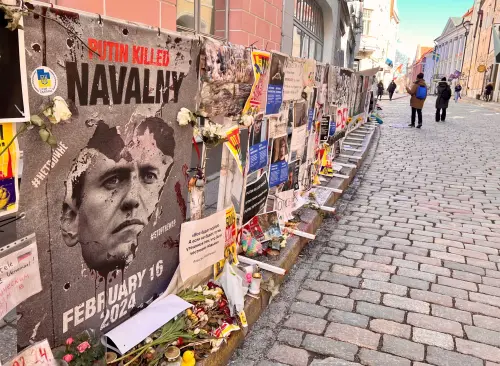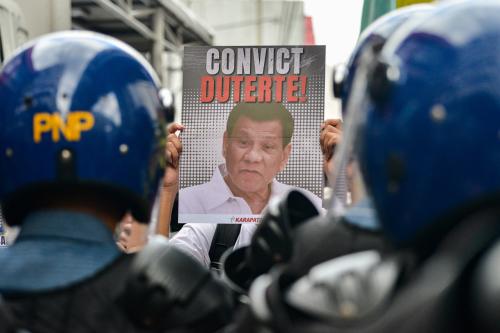

11:00 am EST - 12:30 pm EST
Past Event
Recognizing the need for India to participate more fully in the international non-proliferation system, in late 2009 the Nuclear Threat Initiative (NTI) and the South Asia Program at CSIS created a Working Group on an Expanded Nonproliferation System to discuss three key issues: nuclear security, nuclear disarmament, and the possibilities for U.S.-India cooperation.
In its final report (accessible on the NTI website), the group recommended that India, while unable to join the Nuclear Non-Proliferation Treaty (NPT), could work together with the United States to bring India into the export control groups affiliated with the non-proliferation system.
This private discussion held at the Brookings Institution with American and Indian experts, including some of the working group’s members, began where the report ended – with a look at the structure of international efforts to reduce nuclear danger.
Stephen P. Cohen, senior fellow at the Brookings Institution and moderator of the session, introduced the discussion by mentioning three paradoxes created by the nuclearization of South Asia:
Nuclear weapons cannot realistically be used, but to be an effective deterrent a state must be prepared to use them at any time, especially during crises.
Nuclear weapons are a symbol of national power and prestige, but new nuclear weapons states are reluctant to assume the responsibility and leadership of managing the global nuclear order.
Nuclear weapons and energy have an immense potential for further development, expansion and sophistication, but that also brings concerns about their safety, security and proliferation.
Teresita C. Schaffer, nonresident senior fellow at Brookings and convener of the working group, commented on the conclusions of the report and made the following five observations:
While the NPT is central to Americans, it’s seen as an obstacle by Indians. One path to progress lies in using and also expanding the non-NPT institutional frameworks, including export control groups and the Fissile Material Cutoff Treaty (FMCT). They provide a means of bringing all willing and responsible nuclear weapons states into a forum on global disarmament. This is a prerequisite for the disarmament progress the NPT itself envisages, and should therefore be an early subject of discussion between India and the United States.
Nuclear security should be “low-hanging fruit.” However, it has been difficult to work on in practice. The Japanese nuclear disaster at Fukushima has reinforced this concern, and led to a new backlash against nuclear power in Indian politics. The next nuclear summit in Seoul, preceded later this month by a Sherpa meeting in Delhi may offer an opportunity to address this difficult issue.
The Comprehensive Test Ban Treaty (CTBT) is going nowhere at present. India will not take it seriously unless the U.S. ratifies it, which is improbable in the current political context. But even if the U.S., India and Pakistan ratified the treaty, it cannot come into effect without the signature of North Korea. This means that it will not turn into a legally binding commitment, and that its main utility lies in its normative value. While Americans and many of the other NPT members have tried to use legally binding regimes to strengthen their security, other countries, including India, are less enthusiastic. This suggests that, at least at a minimum, the world needs to make more effective use of normative statements, since the “last mile” of legal commitments may turn out to be hard to traverse.
The FMCT may be more achievable provided it can be moved to a forum in which no single country can block its progress. Given its higher degree of technicality, including the proposal to control raw materials for production of nuclear weapons, it is less replaceable by a normative statement, but could assume greater importance than the CTBT.
India remains squeamish about multilateral norm-setting: it is uncomfortable with the private character of the World Institute for Nuclear Security and the limited membership of Proliferation Security Initiative, preferring the universal membership of the International Atomic Energy Agency (IAEA), even while not being particularly keen to make it a more muscular organization. This is a perspective Americans can understand. Multilateral rules have at times been very controversial in the U.S., where there is strong political resistance to subjecting to international dispute settlements. But, in order to reduce nuclear threats, how may both countries work together to overcome this discomfort?
Joan Rohlfing, president of the Nuclear Threat Initiative and co-convener of the working group, focused her remarks on the following five issues:
The current system of nuclear governance and security is dominated by voluntary arrangements and predicated on the outmoded belief that individual state decisions and structures can provide sufficient security for dangerous nuclear materials. This idea of individual states’ nuclear “sovereignty” is, however, out of step with contemporary needs and it is therefore urgent to promote a shift in our mindsets and in our practices towards recognizing that with shared interests, there must be shared responsibilities and a much greater degree of collaboration, transparency and accountability.
There is a tension between states’ perceptions of sovereignty over all things nuclear and the increasingly urgent challenge to achieve nuclear security collaboratively. This can be traced to a set of three “international interests,” shared by all states, including:
International interests in nuclear security are dependent upon the continued public and political confidence in nuclear energy, which depends upon how well states do on nuclear safety and security. As the nuclear disasters of Three Mile Island, Chernobyl and Fukushima show, an accident or catastrophe in any one place in the world can have a profound impact on how the public and governments assess nuclear risks, and their willingness to continue to pursue it.
NTI has been dealing closely with these challenges, most recently by developing a nuclear materials security index, assessing on a state-by-state basis the security conditions within a given state. One of the main findings is that there is no consensus view on what things a state should do to have strong nuclear materials security, and that most states tend to look narrowly only at the physical protection measures in place at a particular facility.
India must play a greater role, working with other nuclear powers on transparency, global best practices, peer reviews, and regional cooperation. These are crucial issues on which Indian contributions have so far been minimal and insufficient.
P.R. Chari, visiting professor at the Institute for Peace and Conflict Studies (New Delhi) and member of the working group, forwarded the following observations:
The promise of the Indo-U.S. nuclear deal has not been realized, as India remains out of the Nuclear Suppliers Group (NSG), Missile Technology Control Regime (MTCR), Australia Group and Wassenaar Arrangement. 2011 saw more contention than cooperation, especially on enrichment and reprocessing technologies, India’s Civil Nuclear Liability Act, and the reservations expressed by several NSG members regarding nuclear cooperation with India unless it joins the NPT.
On a positive note, Australia has finally decided to supply uranium to India, and the Indo-U.S. dialogue continues on strategic and nuclear issues, which is important for mutual understanding and for greater American appreciation of the constraints on nuclear issues imposed by India’s democratic coalition politics and civil society.
Specifically, on nuclear arms control and non-proliferation, three assertions are possible:
After the Fukushima accident, nuclear safety and security have gained salience and led to great public alarm about nuclear energy. Four specific questions arise:
The future U.S.-India dialogue will have to address the following questions:
The discussion centered on the following three issue-areas:
1. Why is it so difficult for the U.S. and India to cooperate on nuclear issues?
2. Lack of independent domain expertise and regulatory authority in India.
3. What are the avenues for future cooperation between the United States and India?

Angela Stent
April 2, 2025

John Mukum Mbaku
April 2, 2025

Kelebogile Zvobgo
April 1, 2025